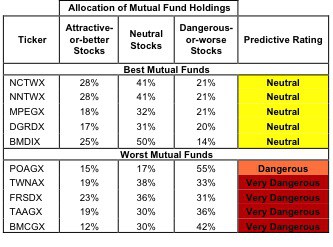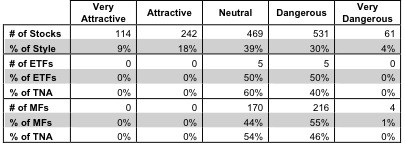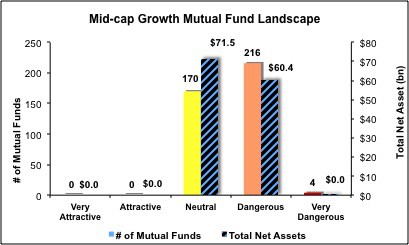The Mid Cap Growth style ranks sixth out of the twelve fund styles as detailed in my style rankings for ETFs and mutual funds. It gets my Dangerous rating, which is based on aggregation of ratings of 10 ETFs and 390 mutual funds in the Mid Cap Growth style as of October 17, 2012. Prior reports on the best & worst ETFs and mutual funds in every sector and style are here.
Figure 1 ranks from best to worst the eight mid-cap growth ETFs that meet our liquidity standards and Figure 2 shows the five best and worst-rated mid-cap growth mutual funds. Not all Mid Cap Growth style ETFs and mutual funds are created the same. The number of holdings varies widely (from 21 to 454), which creates drastically different investment implications and ratings. The best ETFs and mutual funds allocate more value to Attractive-or-better-rated stocks than the worst, which allocate too much value to Neutral-or-worse-rated stocks.
To identify the best and avoid the worst ETFs and mutual funds within the Mid Cap Growth style, investors need a predictive rating based on (1) stocks ratings of the holdings and (2) the all-in expenses of each ETF and mutual fund. Investors need not rely on backward-looking ratings. My fund rating methodology is detailed here.
Investors should not buy any Mid Cap Growth ETFs or mutual funds because none get an Attractive-or-better rating. If you must have exposure to this style, you should buy a basket of Attractive-or-better rated stocks and avoid paying undeserved fund fees. Active management has a long history of not paying off.
Get my ratings on all ETFs and mutual funds in this style on my free mutual fund and ETF screener.
Figure 1: ETFs with the Best & Worst Ratings – Top 3
* Best ETFs exclude ETFs with less NAV’s less than 100 million.
Sources: New Constructs, LLC and company filings
ProShares Ultra Russell MidCap Growth UKW and PowerShares RAFI Fundamental Pure Mid Growth Portfolio PXMG are excluded from Figure 1 because their total net assets (TNA) are below $100 million and do not meet our liquidity standards.
Figure 2: Mutual Funds with the Best & Worst Ratings – Top 5
* Best mutual funds exclude funds with NAV’s less than 100 million.
Sources: New Constructs, LLC and company filings
Four funds were excluded from Figure 2 because their total net assets (TNA) are below $100 million and do not meet our liquidity standards.
Vanguard Mid-Cap Growth ETF VOT is my top-rated Mid Cap Growth ETF and Nicholas II, Inc. NCTWX is my top-rated Mid Cap Growth mutual fund. Both earn my Neutral rating.
First Trust Mid Cap Growth AlphaDEX Fund FNY is my worst-rated Mid Cap Growth ETF and Bhirud Funds, Inc: Apex Mid Cap Growth Fund BMCGX is my worst-rated Mid Cap Growth mutual fund. FNY earns my Dangerous, while BMCGX receives my Very Dangerous rating.
Figure 3 shows that 356 out of the 1417 stocks (over 27% of the total net assets) held by Mid Cap Growth ETFs and mutual funds get an Attractive-or-better rating. However, no Mid Cap Growth ETFs or mutual funds receive an Attractive-or-better rating.
The key takeaway is: there are Attractive stocks held by Mid Cap Growth funds, but mutual fund managers do a poor job allocating investments to them and ETFs do not hold enough of them.
Figure 3: Mid Cap Growth Style Landscape For ETFs, Mutual Funds & Stocks
As detailed in “Cheap Funds Dupe Investors”, the fund industry offers many cheap funds but very few funds with high-quality stocks, or with what I call good portfolio management.
Investors should not buy any Mid Cap Growth ETFs and mutual funds. No Mid Cap Growth ETF or mutual fund allocates enough value to Attractive-or-better-rated stocks to earn an Attractive-or-better rating. Investors seeking exposure to Mid Cap Growth stocks are better off buying Attractive-or-better- rated Mid Cap Growth stocks.
Patterson Companies, Inc. PDCO is one of my favorite stocks held by Mid Cap Growth ETFs and mutual funds. It earns my Attractive rating. Patterson is a value-added distributor serving the dental, veterinary, and rehab markets. It has earned positive economic earnings every year in the 15 years covered by my model. Only 6% of the 3000+ companies we cover can match that achievement. In addition, PDCO has grown its economic earnings 14 out of the past 15 years. Considering this growth in profitability, you would think the market would have priced further growth into PDCO’s current stock price. Yet, PDCO only trades at a price-to-economic book value of 1.14. Considering PDCO’s record of value creation, market expectations are quite low for a company that generated free cash flow in excess of $260 million last year. For these reasons, I favor this Attractive stock over the Neutral-or-worse rated ETFs and mutual funds in the Mid Cap Value style category.
Louisiana-Pacific Corporation LPX is one of my least favorite stocks held by Mid Cap Growth ETFs and mutual funds and earns my Dangerous rating. During the past year, LPX stock has risen over 100%, while the S&P500 has risen 17.5%. This has resulted in a forward P/E of 26.6x next year’s earnings. This recent outperformance has been great for current shareholders, but it does not make LPX an Attractive investment for prospective shareholders. In addition, LPX has had negative economic earnings for the past 5 years. Even worse, LPX’s NOPAT has been negative over the past five years as well. Without operating profits, there is no way for LPX to cover its cost of capital. This combination of a steep valuation and poor profitability makes LPX a Dangerous stock.
Figures 4 and 5 show the rating landscape of all Mid Cap Growth ETFs and mutual funds.
Our style rankings for ETFs and mutual funds report ranks all styles and highlights those that offer the best investments.
Figure 4: Separating the Best ETFs From the Worst Funds
Figure 5: Separating the Best Mutual Funds From the Worst Funds
Review my full list of ratings and rankings along with reports on all 10 ETFs and 390 mutual funds in the Mid Cap Growth style.
Disclosure: I receive no compensation to write about any specific stock, sector, style or theme.
© 2025 Benzinga.com. Benzinga does not provide investment advice. All rights reserved.
Trade confidently with insights and alerts from analyst ratings, free reports and breaking news that affects the stocks you care about.




